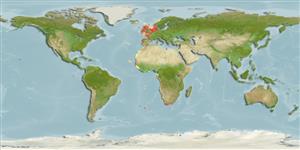Common names from other countries
Classification / Names / Names
Common names | Synonyms | Catalog of Fishes (gen., sp.) | ITIS | CoL | WoRMS
Malacostraca >
Decapoda (Lobster, shrimp and crabs) >
Majidae (spider crabs)
Environment: milieu / climate zone / depth range / distribution range
Ecology
Benthic; depth range 0 - 80 m (Ref. 104052). Temperate
Eastern Atlantic and the Mediterranean: from the North Sea to Morocco and Bay of Biscay, extending southwards to Namibia including off lying islands.
Length at first maturity / Size / Weight / Age
Maturity: Lm 13.0 range ? - ? cm Max length : 22.0 cm CL male/unsexed; (Ref. 104052)
Maximum depth from Ref. 115714.
Life cycle and mating behavior
Maturity | Reproduction | Spawning | Eggs | Fecundity | Larvae
Members of the order Decapoda are mostly gonochoric. Mating behavior: Precopulatory courtship ritual is common (through olfactory and tactile cues); usually indirect sperm transfer.
Le Pape, O., L. Baulier, A. Cloarec, J. Martin, F. Le Loc'h and Y. Désaunay. 2007. (Ref. 96498)
IUCN Red List Status (Ref. 130435: Version 2024-1)
CITES status (Ref. 108899)
Not Evaluated
Not Evaluated
Threat to humans
Harmless
Human uses
Fisheries: commercial
| FishSource |
Tools
More information
Age/SizeGrowthLength-weightLength-lengthMorphologyLarvaeAbundance
Internet sources
Estimates based on models
Resilience
High, minimum population doubling time less than 15 months (Fec=300,000).
Vulnerability
Low vulnerability (12 of 100).
